Samsung Galaxy Ace 2 Full Specification
Samsung Galaxy Ace 2: A Retrospective: Samsung Galaxy Ace 2 Full Specification
Samsung galaxy ace 2 full specification – The Samsung Galaxy Ace 2, launched in 2012, represented Samsung’s continued push into the affordable smartphone market. Positioned as an accessible device with respectable specifications, it aimed to provide a compelling Android experience for budget-conscious consumers. Marketing materials highlighted its improved performance over its predecessor, along with a more refined design and enhanced multimedia capabilities. This review will delve into its specifications, performance, and lasting impact.
Device Overview

Source: photobucket.com
The Samsung Galaxy Ace 2 was a mid-range Android smartphone released in 2012. It built upon the success of its predecessor, offering a more powerful processor, improved camera, and a sleeker design. Key selling points emphasized in its marketing included its speed, enhanced camera capabilities, and its intuitive user interface. The phone aimed to provide a balanced package of performance and features at a competitive price point.
- Sleek and compact design
- Improved processing power
- Enhanced camera features
- User-friendly Android interface
- Affordable price point
Technical Specifications

Source: futurecdn.net
The Galaxy Ace 2 boasted specifications that were competitive for its time in the mid-range segment. Its processor, while not a flagship-level component, provided adequate performance for everyday tasks and light gaming. RAM and storage options influenced the overall user experience, impacting multitasking capabilities and app storage space. The screen resolution and technology were comparable to other devices in its price range.
| Feature | Specification | Unit | Notes |
|---|---|---|---|
| Processor | Dual-core 800 MHz | MHz | Performance comparable to other mid-range processors of 2012. |
| RAM | 768 MB | MB | Sufficient for basic multitasking but could be limiting for demanding apps. |
| Storage | 4 GB (expandable) | GB | Expandable storage via microSD card alleviated storage limitations. |
| Display | 3.8 inches, 480 x 800 pixels | inches, pixels | WVGA resolution, typical for mid-range phones of the era. |
| Operating System | Android 2.3 (Gingerbread), upgradable to 4.0 (Ice Cream Sandwich) | – | Software updates extended the device’s lifespan and feature set. |
Camera Capabilities, Samsung galaxy ace 2 full specification
The Galaxy Ace 2 featured a camera with capabilities that were decent for its time. While not boasting high megapixel counts common in modern smartphones, it offered features that enhanced image quality and usability. Video recording capabilities were adequate for casual use.
The camera’s performance was comparable to other mid-range phones of 2012. Image quality was acceptable in good lighting conditions, but struggled in low-light scenarios. Video recording quality was sufficient for sharing online but lacked the clarity and detail of higher-end devices.
| Feature | Galaxy Ace 2 | Competitor A | Competitor B |
|---|---|---|---|
| Megapixels | 5 MP | 5 MP | 8 MP |
| Autofocus | Yes | Yes | Yes |
| Flash | LED | LED | LED |
| Video Recording | 720p | 720p | 1080p |
(Note: Competitor A and B are placeholder names; specific competitors would need to be identified for accurate comparison.)
Software and User Experience
The Samsung Galaxy Ace 2 originally shipped with Android 2.3 (Gingerbread), later receiving an update to Android 4.0 (Ice Cream Sandwich). The TouchWiz UI, Samsung’s custom skin, offered a familiar Android experience with some added Samsung-specific features and customizations. Pre-installed apps included typical Google apps, along with some Samsung-branded applications. Due to its age, the device’s software is no longer supported with security updates and lacks access to the latest Android features.
Connectivity and Battery
The Galaxy Ace 2 offered standard connectivity options for its time, including Wi-Fi, Bluetooth, and cellular data. The battery life was reasonable for everyday use, but fell short of the standards set by modern smartphones with larger batteries and power-efficient processors. Charging technology was standard for the time, lacking the fast-charging capabilities found in modern devices.
Physical Design and Dimensions
The Galaxy Ace 2 featured a compact and relatively lightweight design. Its dimensions and weight were typical for smartphones of its era. The device’s construction primarily used plastic materials, reflecting the cost-effectiveness of its design. The phone featured a standard layout with buttons and ports positioned conventionally.
Legacy and Impact
The Samsung Galaxy Ace 2 was a commercially successful device, contributing to Samsung’s growth in the smartphone market. It solidified Samsung’s position as a provider of affordable yet capable Android smartphones. While not a groundbreaking device, it represented a step forward in terms of performance and features for its price point, influencing subsequent models in Samsung’s mid-range lineup.
User reviews from the time were generally positive, praising its performance and affordability.
Quick FAQs
Was the Samsung Galaxy Ace 2 waterproof?
No, the Samsung Galaxy Ace 2 was not waterproof.
Did the Samsung Galaxy Ace 2 have expandable storage?
Finding the full specifications for the Samsung Galaxy Ace 2 can be a bit of a quest, especially when comparing it to newer models. You might find it helpful to contrast its features against a more modern device, like the Samsung Galaxy A7 Star, whose specifications you can find here: samsung galaxy a7 star specification. This comparison will highlight the significant advancements in technology between the two phones, ultimately providing a clearer picture of the Galaxy Ace 2’s capabilities within its time.
Yes, it typically offered microSD card expansion for increased storage.
What was the battery life like on the Samsung Galaxy Ace 2?
Battery life varied depending on usage, but generally provided a moderate amount of talk and standby time compared to modern smartphones.
What type of charging technology did the Samsung Galaxy Ace 2 use?
It used standard USB charging for its time, not fast charging.





















